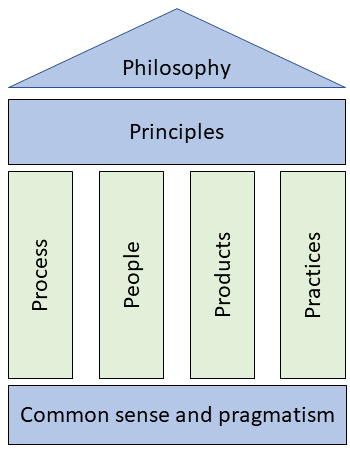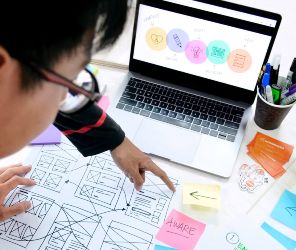
Founding
DSDM or Dynamic Systems Development Method, is often considered the best kept secret of the Agile universe. Initiated in 1995, DSDM boasts the longest history among Agile methods and is the only method that centers on managing Agile projects.
After 2000, DSDM became popular among software developers seeking alternatives to rapid application development (RAD) methods. A key challenge with RAD was its lack of scalability for team collaboration. DSDM addressed this by promoting collaboration and scalability within teams, making it one of the earliest Agile methodologies implemented by the software development community.
DSDM was instrumental in the formation of the Agile Alliance and the Agile Manifesto in 2001. Its guiding principles and philosophy had an impact on the Manifesto for Agile Software Development, although DSDM broadens the Agile concept beyond just software.
To put it succinctly, DSDM was Agile before the term became widely known!
The DSDM Atern Development
In 2007, the DSDM methodology underwent a major update, resulting in the formation of DSDM Atern. The name ‘Atern’ was borrowed from the Arctic Tern, a bird celebrated for its outstanding collaborative nature and ability to travel extensive distances. This metaphor fittingly reflected the rebranding of the DSDM method.
By 2014, confusion surrounding the term ‘Atern’ led to another update to the method. The choice was made to revert to the original DSDM name, as it was a brand that everyone recognized. As a result, DSDM and DSDM Atern now have the same meaning!
DSDM’s Introduction of the Agile Project Framework
The 2014 rebranding of DSDM involved the integration of the Agile Project Framework. The DSDM Agile Project Framework is now the principal, tested agile approach that caters to the dual needs of modern organizations: governance and rigor, alongside agility and flexibility.
DSDM’s Agile Project Framework enables organizations to address frequent project challenges such as delayed completion, cost overruns, or unsuitable final deliverables.
DSDM and AgilePM Integration
DSDM became the first agile framework to incorporate agile project management capabilities. In contrast to Scrum, which solely emphasizes product delivery during an iteration, DSDM also focuses on project management aspects, setting it apart from the majority of other agile frameworks.
Because of DSDM’s capacity to meet various agile needs, it was chosen as the foundation for the quickly growing AgilePM (Agile Project Management) qualifications, accredited by APMG International and the Agile Business Consortium.
DSDM – An Agile Technique
DSDM is an iterative agile framework initially created to efficiently deliver software projects. Like other agile frameworks and approaches, DSDM was developed in response to the problematic waterfall processes that had become common in the software development industry during the late 20th century.
DSDM’s Growth
DSDM is now experiencing growth as agile methodologies mature. This growth is due to organizations requiring greater rigor and control when implementing agile in situations where the ‘ideal agile environment’ is lacking.
DSDM is an agile method that caters to both straightforward product development projects with co-located teams and more complex projects involving multiple distributed teams across different countries and time zones. DSDM can scale up to accommodate multiple teams working in distributed settings, a feature that scaled agile frameworks have only recently begun to offer.
DSDM Key Points
Not Limited to IT
DSDM’s origins, like most agile frameworks and methods, can be traced back to the software development industry. However, agile has evolved over the past decade and is no longer limited to IT.
DSDM can easily be applied to projects outside of software development. In fact, it can be used in any type of product development project. By delivering a functional product incrementally at the end of each timebox, DSDM can provide business value early in the product development lifecycle.
DSDM: Standalone or Complementary
The DSDM Agile Project Framework can be used either as a standalone method or combined with other well-established project management methods such as PRINCE2, MSP, and PMI.
It is also an excellent wrapper for more limited Agile approaches like Scrum, ensuring that the entire project lifecycle is covered. DSDM also enables Scrum to be scaled up for use beyond just product development.
DSDM Composition

DSDM is an agile project framework made up of several elements:
- philosophy
- principles
- products
- people
- process
- practices
- pragmatism and common sense.
Together, these elements support a philosophy of delivering business benefits as early as possible to achieve the best possible return on investment (ROI) for an organization.
DSDM’s ‘reasonableness and pragmatism’ might seem peculiar to some, but this flexibility allows DSDM to sidestep the dogma that can surround other Agile approaches.
A core assumption of DSDM is that nothing is built flawlessly the first time. Generally, 80% of a solution’s value can be delivered for 20% of the effort it takes to create the entire solution.
By focusing on the business need, DSDM supports projects that strategically align with the organization’s change portfolio.
DSDM Key Principles
DSDM is built on 8 key principles that reflect its values, culture, and working style. These principles need to be actively managed at all times, as a compromised principle can threaten the successful execution and completion of a project.
DSDM closely adheres to agile principles, with a focus on delivery, effective communication, collaboration, and continuous delivery. All DSDM principles serve to align DSDM practices within the agile philosophy.
Mastering the guiding principles of DSDM is vital if you plan to pursue an agile project management course such as AgilePM®, which is based on the DSDM method.
We will now look at the 8 DSDM principles.
1. Focus on the business need
- Understand business priorities.
- Create a valid business case.
- Enable continuous business commitment.
Every decision made within your project should align with the broader project goals. Projects must serve as a means to accomplish long-term business goals. Employing techniques such as MoSCoW and timeboxing assists in keeping the focus on delivering what businesses need, at the time they need it.
2. Deliver on time
- Use timeboxing.
- Focus on priorities.
- Predict deliveries.
Meeting delivery deadlines is usually crucial. To achieve reliable deliveries, arrange all timeboxes in advance. Though features may fluctuate, the delivery dates must never change.
3. Cooperate and collaborate
- Promote stakeholder collaboration.
- Focus on team building.
- Work with business representatives.
Collaboration and decision-making on behalf of represented parties should be possible for teams. Incorporate subject matter experts within your team to encourage knowledge dissemination. Regular workshops allow stakeholders to share their understanding and experiences with project teams.
4. Never compromise quality
- Set quality level at the start.
- Ensure quality doesn’t vary.
- Document and test.
Determine the level of quality to be pursued at the project’s initiation. All tasks should work towards achieving this consensus. Test outcomes early and consistently revise them.
5. Build incrementally
- Deliver business benefit early.
- Reassess priorities with each iteration.
- Confirm that the work is correct.
DSDM requires teams to first understand the scope of the business problem they are tackling before commencing development. Avoid becoming overly fixated on the minutiae of requirements analysis, which could inhibit development.
6. Develop iteratively
- Use customer feedback.
- Create Enough Design Up Front (EDUP).
- Evolve and be creative.
Iterative delivery is a vital component of DSDM. Realize that it’s rare for something to be impeccable on the first attempt and be willing to welcome changes within your project for a successful outcome.
7. Communicate continuously
- Manage expectations.
- Keep documentation simple.
- Interact through workshops.
Motivate team interaction by arranging stand-ups and workshops. Display your work consistently and early through models and prototypes. Consistently encourage casual, face-to-face exchanges within the team.
8. Demonstrate control
- Be proactive.
- Timebox work and review regularly.
- Evaluate project viability.
Promote project control by keeping plans and progress open to everyone’s view. Establish and maintain formal documentation procedures. Evaluate progress according to the products delivered, not the tasks completed.
DSDM Processes
DSDM implements both iterative and incremental strategies. The most crucial business requirements are addressed early on, and less critical ones are dealt with later.
Due to its iterative nature, DSDM enables business representatives to monitor a solution as it evolves, provide their insights, and suggest changes throughout the development process.
Phases
The DSDM process model incorporates 6 phases. Its unique pre-project phase and post-project phase distinguish it from the majority of Agile methods that prioritize delivery exclusively.
The phases are:
- Pre-project.
- Feasibility.
- Foundations.
- Evolutionary development.
- Deployment.
- Post-project.
People
DSDM integrates people from the business and development sectors during the course of its iterative and incremental stages.
All participants in a project are provided with well-defined roles and tasks and work together in timeboxes to ensure timely project completion.
In contrast with other Agile methods, DSDM delineates the project manager’s functions.
Practices
DSDM advocates 4 fundamental practices.
Timeboxing
In DSDM, work is organized in fixed time segments (timeboxes) like Scrum’s sprints, which is a common feature of many agile frameworks. The goal is to deliver a usable product after each iteration (timebox). Consequently, DSDM follows both an incremental and iterative approach to product development.
Facilitated workshops
Facilitated workshops bring project stakeholders together to collaborate on defining business requirements and fostering a shared understanding.
Modelling and iterative development
Modelling allows team members to visualize a business domain and deepen their knowledge of it. Modelling is used to create graphic representations of specific aspects of the system or business area in development.
DSDM relies on a brief feedback loop with the client to deliver a working software increment at the end of each iteration. It recommends using the MoSCoW prioritization technique to determine which requirements the team should work on during a timebox. Requirements are typically captured as user stories.
DSDM also employs prototyping, with an emphasis on rapid construction, swift feedback, and early problem detection. The underlying DSDM philosophy is that it’s preferable to identify and resolve issues as soon as possible.
MoSCoW prioritization
MoSCoW prioritization helps businesses classify requirements by determining Must have, Should have, Could have, and Won’t have requirements within each timebox.
DSDM in Relation to Scrum
A common misperception within the Agile community is that Scrum functions as a project management methodology. However, Scrum is actually a development method that encourages team collaboration on project and non-project tasks to iteratively produce valuable products for customers.
Scrum does not cover the steps before a project (pre-project) or after the solution is implemented (post-project). The pre-project phase involves evaluating the project’s worthiness, while the post-project phase concerns measuring the benefits of the solution and determining any necessary improvements.
In comparison, DSDM encompasses the pre-project and post-project phases and defines the project manager’s responsibilities. DSDM operates as an agile project management framework, whereas Scrum is a product delivery framework. Scrum can still be integrated into DSDM projects during the remaining four project stages.
DSDM infographic
The following infographic shows the DSDM principles in greater detail.

Summary
The DSDM Agile Project Framework offers a dependable and time-tested method for agile project delivery, having been successfully applied in a wide range of projects worldwide.
DSDM remains the only agile project management framework available today. The framework consistently showcases its ability to work efficiently within and complement existing corporate processes.
DSDM’s use in IT and non-IT projects dates back to 1994, and its substantial productivity gains have been independently verified by the UK Software Metrics Association.
For more information on how DSDM can enhance your Agile project delivery, or for details about agile project management training, please contact us at agileKRC.
agileKRC has helped shape agile thinking by leading the teams that developed AgilePM® and PRINCE2 Agile®. We take a practical, success-oriented approach. We begin by taking the time to listen and understand your needs, before offering our real-world experience and expert guidance.













